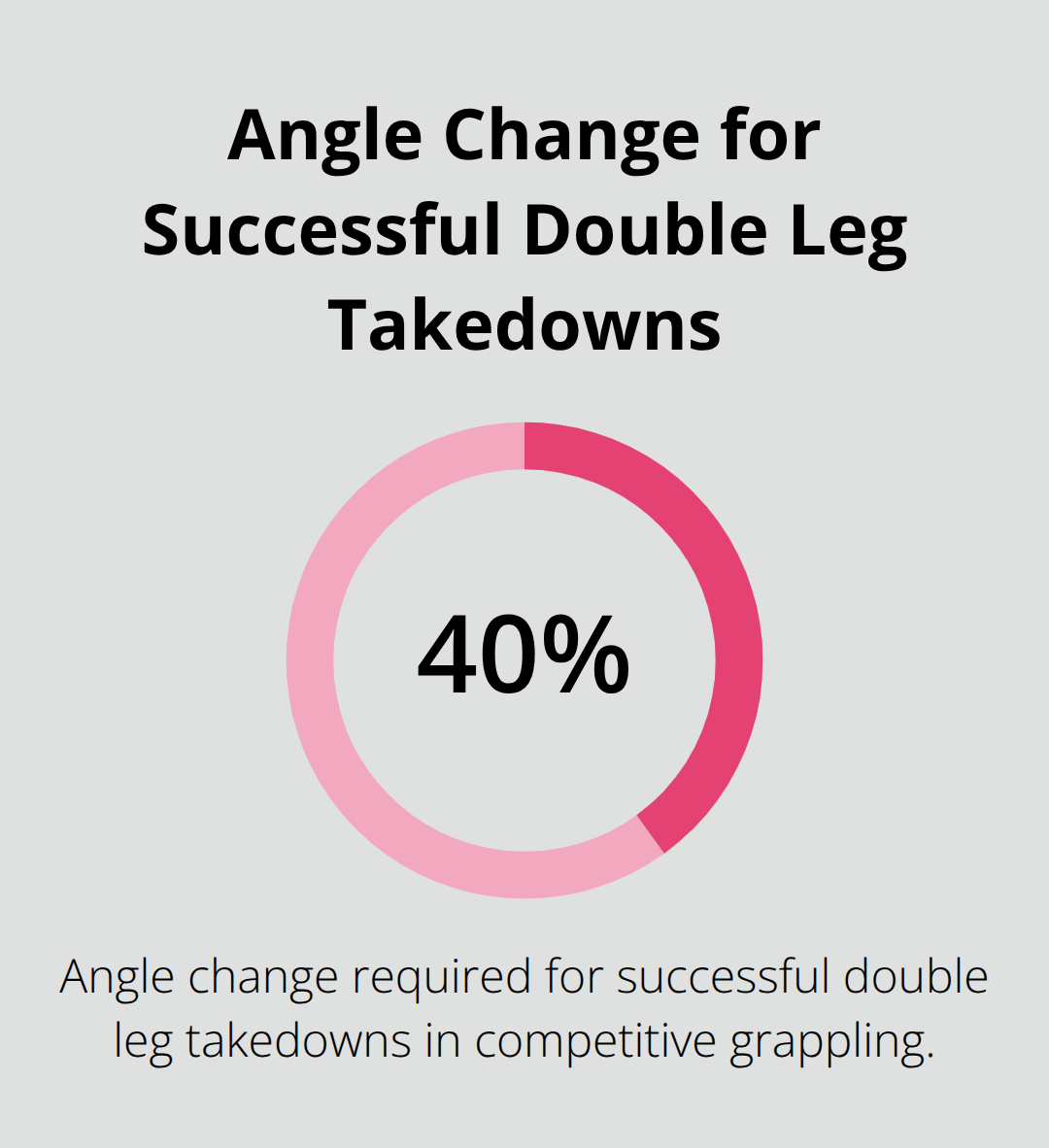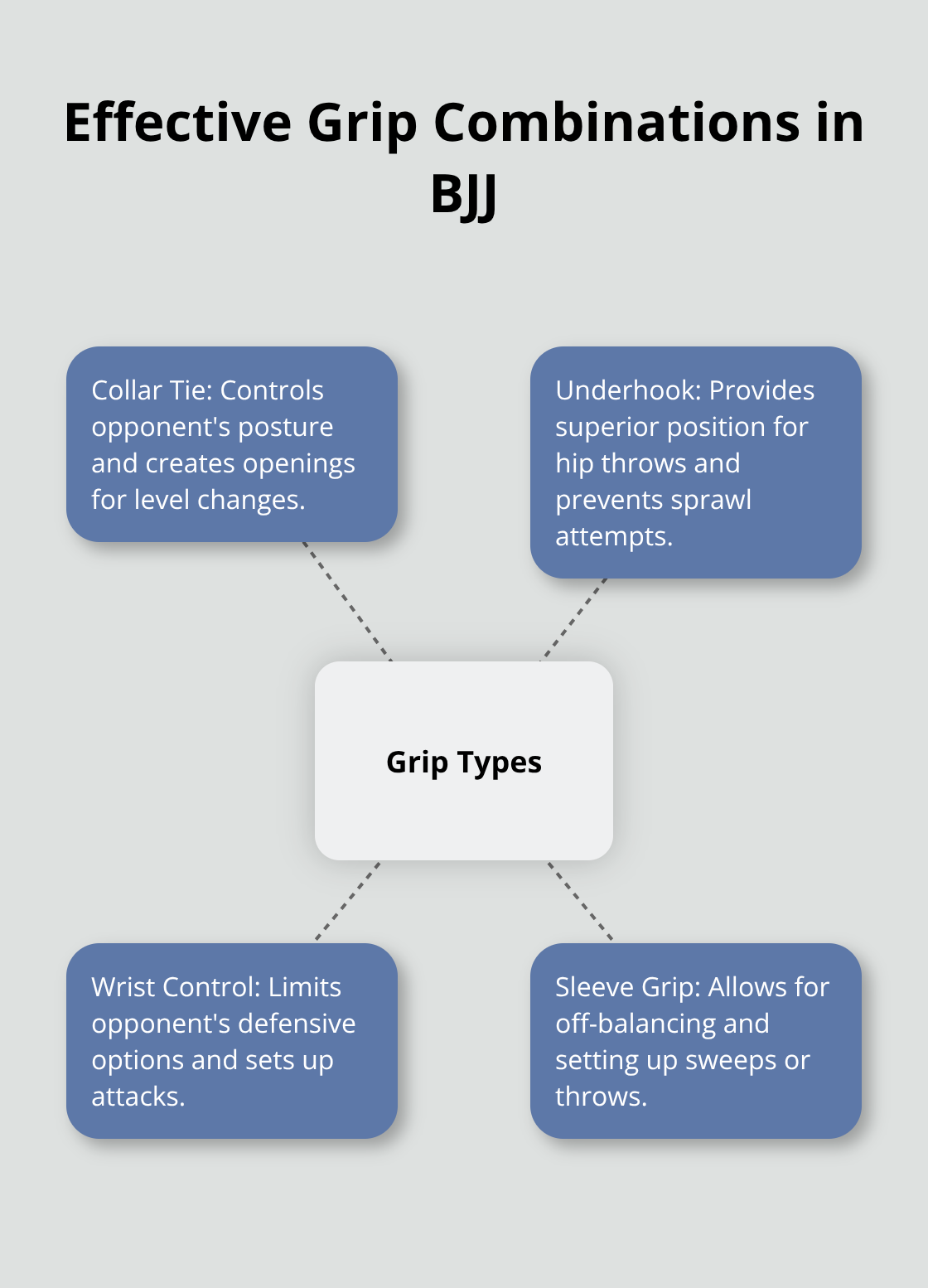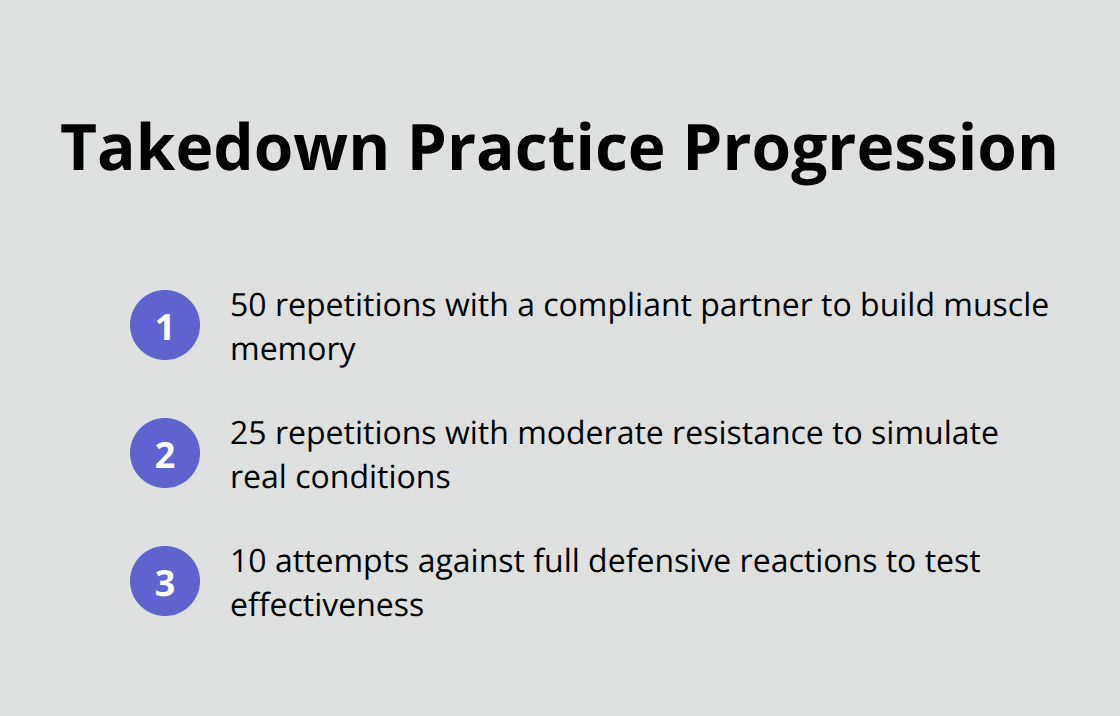Getting your opponent to the ground is where most Jiu Jitsu matches are won or lost. We at Jiu Jitsu see too many practitioners struggle with this fundamental skill.
Mastering Jiu Jitsu takedowns requires understanding proper mechanics, timing, and strategic combinations. The difference between landing on top versus bottom position often determines the entire match outcome.
Which Takedowns Should You Master First?
Single Leg Takedown Fundamentals
The single leg takedown forms the backbone of effective ground entries in Brazilian Jiu-Jitsu. Your setup begins with a collar tie or underhook, which creates the angle you need to penetrate your opponent’s defense. Drop your level while you step your outside foot between their legs, then drive your shoulder into their midsection. The International Brazilian Jiu-Jitsu Federation emphasizes proper head placement on the outside of the leg you attack. Your grip should circle the leg just above the knee, pull it tight to your chest while your free hand controls their hip or pushes their opposite shoulder. The finish requires you to drive forward and up, lift the trapped leg while you step your feet in small circles to break their balance. Common mistakes include reach too far or fail to maintain proper posture during the attack.
Double Leg Power and Timing
Double leg takedowns demand explosive penetration and precise timing to succeed against skilled opponents. Your entry starts from a neutral position, drop your level dramatically while you shoot both hands behind your opponent’s knees. Your head should drive into their stomach, not their chest, to avoid an underhook opportunity. The grip involves lace your fingers together or use a gable grip (this depends on your hand size and strength). Studies from competitive grappling show that successful double legs require a 40-degree angle change during the shot. Your drive phase must be continuous – pause for even a second and your opponent will sprawl or counter. The finish involves lift their legs while you drive forward, then step to one side to avoid their guard. Practice this technique with partners of different weights, as heavier opponents require different lift mechanics than lighter ones.

Hip Throws That Actually Work
Hip throws offer high-percentage opportunities when your opponent posts or reaches. The basic hip toss starts with an underhook and collar tie, position your hip below theirs while you maintain close contact. Your throw hip becomes the fulcrum, which requires you to turn your toes and knees in the direction of the throw. The key lies in the timing – execute the throw as your opponent steps forward or shifts their weight. Your underhook arm lifts while your collar tie pulls them over your hip. Unlike judo applications, BJJ focuses on grappling and ground fighting rather than perfect throw execution. The tomoe nage sacrifice throw provides an excellent backup option when your opponent defends the hip toss, allows you to pull guard while potentially sweep them over your head.
These fundamental techniques provide the foundation you need, but advanced practitioners combine multiple attacks to overwhelm their opponents’ defenses.
How Do You Set Up Multiple Takedown Attacks?
Single takedowns rarely work against experienced opponents who expect your attacks. We at Jiu Jitsu recommend that you master chain wrestling combinations that flow seamlessly between different techniques. Start with a single leg attempt, and when your opponent sprawls or defends, immediately transition to an ankle pick or double leg. The key lies in how you maintain forward pressure throughout each transition. Your first attack creates the opening for your second or third attempt. Successful takedowns occur more often when fighters use combination attacks versus isolated techniques.
Build Effective Grip Combinations
Your grip fighting determines takedown success before you ever shoot. Establish collar ties and underhooks early, then use these grips to create angles and openings. The collar tie allows you to control your opponent’s posture while you snap their head down, which creates opportunities for level changes. Underhooks provide superior position for hip throws and prevent your opponent from sprawl attempts. Practice grip fighting for 30 seconds before each takedown attempt during drill sessions. Switch between different grip combinations every 10 seconds to develop adaptability. Strong grip fighters win more takedown exchanges according to wrestling performance analysis.

Counter Common Defensive Patterns
Most BJJ practitioners use predictable defensive reactions that you can exploit. When opponents sprawl against your double leg, immediately switch to a single leg or ankle pick on the same side. Their sprawl creates the angle you need for these follow-up attacks. Against defensive circles, use foot sweeps or trips in the direction they move. Time your attacks when they plant their feet to change direction. Opponents who post their hands to defend hip throws expose themselves to arm drags and back takes (this creates immediate opportunities for dominant position). Train specific counter-sequences for each defensive pattern you encounter.
Master the Flow Between Attacks
Smooth transitions between takedown attempts separate advanced grapplers from beginners. Practice specific sequences like single leg to ankle pick to double leg until these combinations become automatic responses. Your opponent’s defense to one attack should trigger your next technique without conscious thought. Drill these flows with resistance from your partner to simulate real match conditions. The best chain wrestlers never pause between attacks – they use their opponent’s defensive energy to fuel the next technique in their sequence.
These combination strategies require dedicated practice time, but the physical conditioning needed to execute them effectively demands a different approach to your training regimen.
How Should You Train Takedowns Effectively
Repetition training forms the foundation of takedown mastery, but most practitioners approach drills incorrectly. We at Jiu Jitsu see fighters waste hours on mindless repetitions that build bad habits instead of muscle memory. Your sessions must include resistance and variations to simulate real match conditions. Practice each takedown sequence 50 times with a compliant partner, then 25 times with moderate resistance, followed by 10 attempts against full defensive reactions. This progression develops the neural pathways needed for automatic execution under pressure. Wrestling coaches emphasize that mastering takedown techniques requires structured training that includes technique checklists and advanced breakdowns.

Progressive Resistance Methods
Start your takedown practice with shadow work to perfect footwork and body mechanics without a partner. Move to cooperative practice where your partner provides minimal resistance, focus on proper angles and grip placement. Advance to situational sparring where you start in specific positions like collar ties or underhook scenarios. Finally, integrate takedowns into live sessions where your opponent actively defends and counters your attacks. This four-stage progression prevents you from development that only works against compliant partners.
Strength Training for Explosive Power
Takedown success depends on explosive hip drive and leg strength more than upper body power. Incorporate hex bar deadlifts and Bulgarian split squats into your routine twice weekly. These exercises develop the posterior chain strength needed for penetration steps and opponent lifts. Add medicine ball slams and broad jumps to build the explosive power required for successful shots. Research from strength and conditioning specialists shows that grapplers who perform plyometric exercises improve their takedown success rate significantly over six months. Your program should emphasize short bursts of maximum effort rather than endurance work.
Live Sparring Integration
Apply your takedown skills during regular sparring sessions to test them under real pressure. Start each round from standing position to force takedown exchanges before ground work begins. Set specific goals like attempting three different takedowns per round or successfully completing one takedown every two rounds. Track your success rate over time to measure improvement and identify weak areas that need more practice time. Consider cross training with wrestling to develop stronger takedown fundamentals and clinch work techniques.
Final Thoughts
Mastery of Jiu Jitsu takedowns demands commitment to fundamental principles that separate successful grapplers from those who struggle on their feet. Your success depends on three core elements: proper timing, explosive execution, and seamless transitions between techniques. These skills develop through consistent practice rather than sporadic sessions.
Technical refinement never stops, even for advanced practitioners. We at Jiu Jitsu observe that fighters who dedicate specific time to takedown practice show measurable improvement in their match performance within months. Your muscle memory builds through repetition, but quality repetition with progressive resistance creates the neural pathways needed for competition success (this applies to both beginners and experienced grapplers).
Confidence in your ground game approach starts when you believe in your takedown abilities. When you trust your techniques, you commit fully to each attempt instead of hesitate at the moment of execution. Souza Grappling Co. provides expert instruction and a supportive community where you can develop your takedown game alongside other dedicated practitioners. Your takedown success directly impacts every other aspect of your Brazilian Jiu-Jitsu game.




